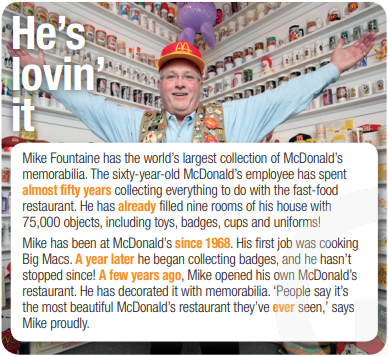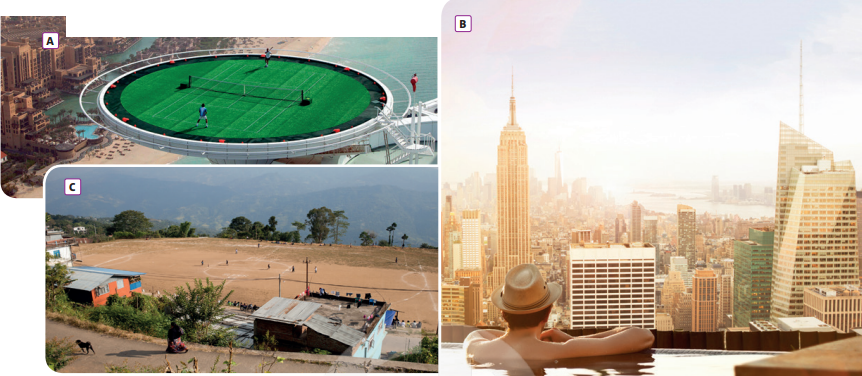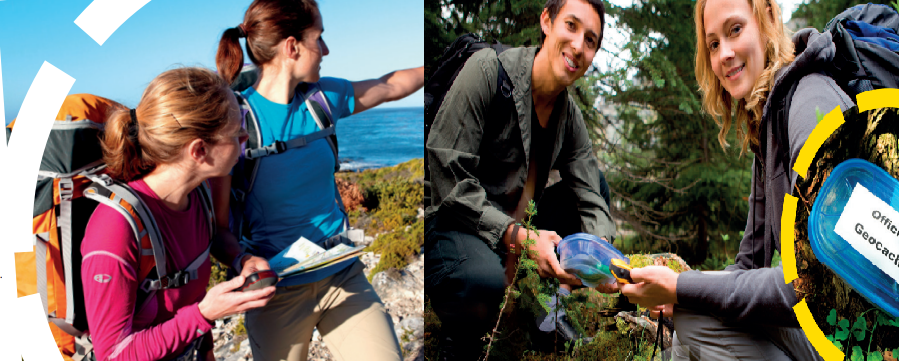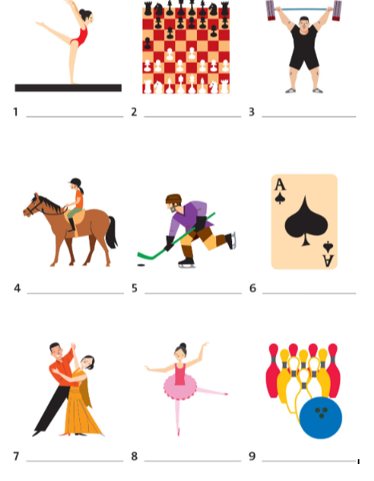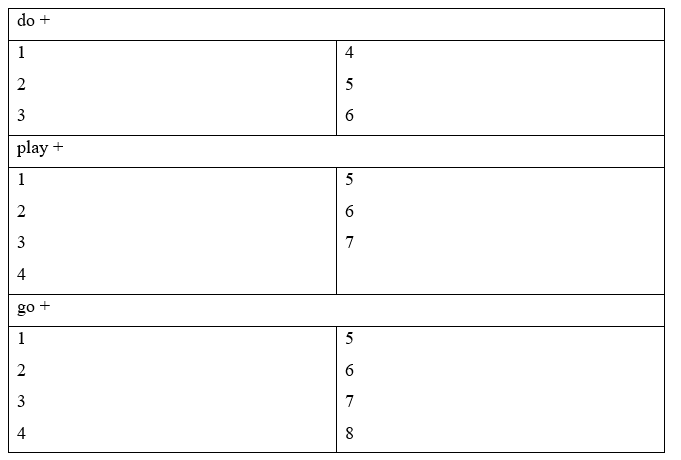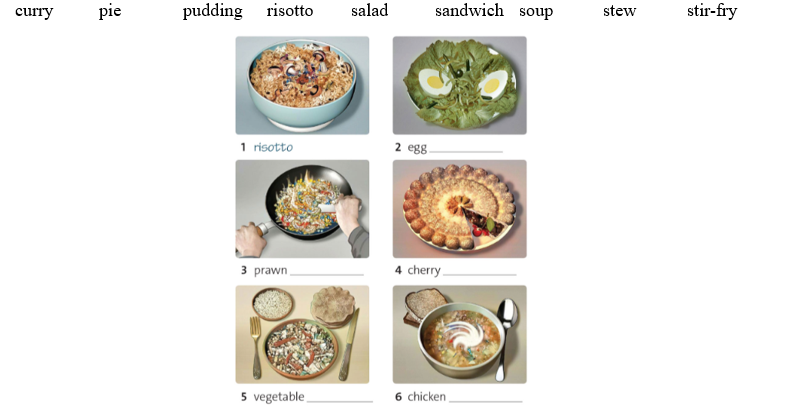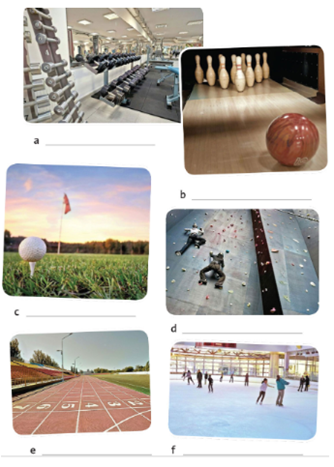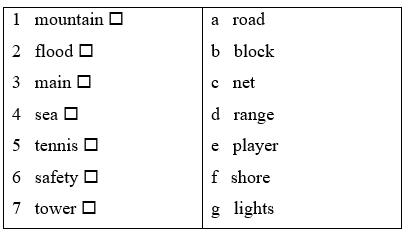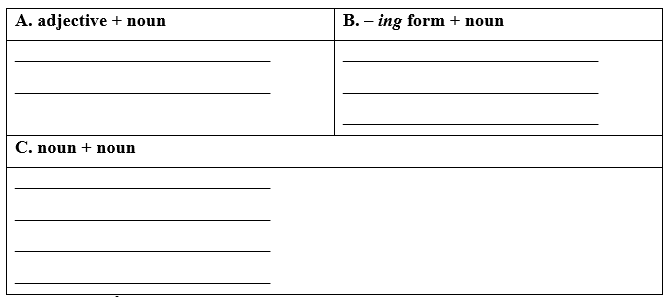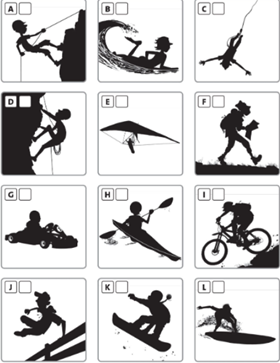Giải SGK, SBT Unit 2. Leisure time Friends Global
Giải SGK, SBT Unit 2 Friends Global
2. VOCABULARY Check the meaning of the activities and sports below. How many can you find in photos A-F?
(Kiểm tra ý nghĩa của các hoạt động và thể thao dưới đây. Có bao nhiêu bạn có thể tìm thấy trong ảnh A-F?)
Activities and sports
|
bake cakes |
collect figures, cards, stamps, etc. |
draw |
hang out with friends |
|
make clothes |
read books |
read magazines |
text your friends |
|
use social media |
video blog |
watch videos online |
|
do, play or go
|
ballet |
ballroom dancing |
basketball |
board games |
|
bowling |
cards |
chess |
cycling |
|
drama |
gymnastics |
ice hockey |
martial arts |
|
a musical instrument |
shopping |
skateboarding |
weights |
|
photography |
rollerblading |
running |
camping |

3. Read the Listening Strategy. Then listen to two extracts and answer the questions.
(Đọc Chiến lược nghe. Sau đó nghe hai đoạn trích và trả lời câu hỏi.)
Extract 1
1. Why is the man talking to the waiter?
(Tại sao người đàn ông nói chuyện với người phục vụ?)
2. What time of the day is the dialogue taking place?
(Cuộc đối thoại diễn ra vào thời gian nào trong ngày?)
Extract 2
3. Who is speaking?
(Ai đang nói?)
4. Where is the speaker?
(Người nói ở đâu?)
|
Listening Strategy (Chiến lược nghe) In a listening task, you sometimes need to identify the implied context of a conversation. You have to listen for clues of the conversation's the place, time, reason and speakers. (Trong một nhiệm vụ nghe, đôi khi bạn cần xác định ngữ cảnh ngụ ý của một cuộc trò chuyện. Bạn phải lắng nghe để tìm manh mối về địa điểm, thời gian, lý do và người nói của cuộc trò chuyện.) |
5. Put the phrases below into the correct group (A, B or C).
(Đặt các cụm từ dưới đây vào nhóm chính xác (A, B hoặc C).)
|
a bit special |
a real let-down |
fine |
nothing special |
|
not up to standard |
out of this world |
pretty average |
|
A. Good_______________________________________
B. OK_________________________________________
C. Bad________________________________________
3. Read the Learn this! box and complete the rules. Use the dialogue to help you. How many examples of this tense are there in the dialogue?
(Đọc khung Learn this! và hoàn thành các quy tắc. Sử dụng cuộc đối thoại để giúp bạn. Có bao nhiêu ví dụ về thì này trong đoạn đối thoại?)
|
LEARN THIS! Present perfect continuous a. We form the present perfect continuous with have/ 1________ + 2________+ -ing form. b. We use the present perfect continuous: 1. for an action that began in the past and is still in progress. You 3_________working much this term. Why not? We often use for or 4_________to say how long the action has been in progress. They 5_________living in Paris 6_________ ten years. 2. for an action that has recently been in progress and which explains the current situation. I'm hot because I 7_________ running. |
5. Read the Leam this! box. Underline an example of the present perfect simple for a completed action in exercise 2.
(Đọc khung Learn this! Gạch dưới một ví dụ về thì hiện tại hoàn thành đơn cho một hành động đã hoàn thành trong bài tập 2.)
|
LEARN THIS! Present perfect simple (LEARN THIS! Thì hiện tại hoàn thành) We use the present perfect simple (Chúng ta sử dụng thì hiện tại hoàn thành đơn) a. for completed actions. (cho các hành động đã hoàn thành.) I've set up a Twitter account. Will you follow me? (Tôi đã thiết lập một tài khoản Twitter. Bạn sẽ theo tôi chứ?) b. when we say how often something has happened. (khi chúng ta nói tần suất điều gì đó đã xảy ra.) Our team has won three times this season. (Đội của chúng tôi đã thắng ba lần trong mùa giải này.) c. with verbs that are not used in continuous tenses. (với những động từ không dùng ở thì tiếp diễn.) I've owed him £50 since the summer. (Tôi đã nợ anh ta £50 kể từ mùa hè.) |
7. SPEAKING Work in pairs. Take turns to be A and B.
(Làm việc theo cặp. Lần lượt là A và B.)
A. Tell your partner that he or she looks
(Nói với bạn của bạn rằng anh ấy hoặc cô ấy trông có vẻ…)
|
exhausted |
guilty |
sleepy |
upset |
|
hot |
worried |
relieved |
|
B. Explain why you look that way. Use the present perfect simple and continuous.
(Giải thích lý do tại sao bạn lại trông có vẻ như thế. Sử dụng thì hiện tại hoàn thành đơn và tiếp diễn.)
A: You look exhausted.
(Trông bạn có vẻ mệt mỏi.)
B: I've been getting up very early for the past few days.
(Tôi đã dậy rất sớm trong vài ngày qua.)
4. Read the Learn this! box. Then look at the compound nouns in exercise 2. Underline at least one example of each type (1, 2 and 3). Which type has the most examples?
(Đọc khung Learn this! Sau đó nhìn vào các danh từ ghép trong bài tập 2. Gạch dưới ít nhất một ví dụ của mỗi loại (1, 2 và 3). Loại nào có nhiều ví dụ nhất?)
|
LEARN THIS! Compound nouns (LEARN THIS! Danh từ ghép) a. Compound nouns are nouns formed from two words. (Danh từ ghép là danh từ được hình thành từ hai từ.) 1. noun + noun (bathroom, safety barrier) (danh từ + danh từ (phòng tắm, hàng rào an toàn)) 2. -ing form + noun (dining room, recording studio) (dạng -ing + danh từ (phòng ăn, phòng thu âm)) 3. adjective + noun (wet room, whiteboard) (tính từ + danh từ (phòng ướt, bảng trắng)) b. We usually write compound nouns as two words, but sometimes as one word (whiteboard) or with a hyphen (make-up). Check in a dictionary. (Chúng ta thường viết các danh từ ghép dưới dạng hai từ, nhưng đôi khi là một từ (bảng trắng) hoặc có dấu gạch nối (trang điểm). Kiểm tra một từ điển.) c. The stress is usually on the first word. (Trọng âm thường ở từ đầu tiên.) |
5. Work in pairs. Match the words in A and B to form sports venues, using a dictionary to help you. Find three more sports venues in exercise 2.
(Làm việc theo cặp. Ghép các từ ở A và B để tạo thành các địa điểm thể thao, sử dụng từ điển để giúp bạn. Tìm thêm ba địa điểm thể thao trong bài tập 2.)
A.
|
athletics |
basketball |
bowling |
boxing |
climbing |
|
dance |
golf |
ice |
weights |
|
B.
|
alley |
room |
course |
court |
ring |
|
rink |
studio |
track |
wall |
|
5. SPEAKING KEY PHRASES Work in pairs. Would you like to play this game? Why? / Why not? Use the adjectives, and phrases below to help you.
(Làm việc theo cặp. Bạn có muốn chơi trò chơi này không? Tại sao? / Tại sao không? Sử dụng các tính từ và cụm từ dưới đây để giúp bạn.)
Adjectives
|
addictive |
boring |
difficult |
exciting |
|
exhausting |
healthy |
time-consuming |
|
Explaining preferences (Giải thích sự yêu thích hơn)
- I'd find it... It sounds really...
(Tôi thấy nó... Nghe có vẻ thực sự...)
- I'd like to play it because...
(Tôi muốn chơi nó vì...)
- It appeals/doesn't appeal to me because...
(Nó hấp dẫn/không hấp dẫn tôi bởi vì...)
- I'm (not) really into... I'd rather... I can't stand...
(Tôi (không) thực sự thích... Tôi muốn... tôi không thể chịu được...)
- I don't mind..., but...
(Tôi không phiền..., nhưng...)
5. SPEAKING KEY PHRASES Work in pairs. Would you like to play this game? Why? / Why not? Use the adjectives, and phrases below to help you.
(Làm việc theo cặp. Bạn có muốn chơi trò chơi này không? Tại sao? / Tại sao không? Sử dụng các tính từ và cụm từ dưới đây để giúp bạn.)
Adjectives
|
addictive |
boring |
difficult |
exciting |
|
exhausting |
healthy |
time-consuming |
|
Explaining preferences (Giải thích sự yêu thích hơn)
- I'd find it... It sounds really...
(Tôi thấy nó... Nghe có vẻ thực sự...)
- I'd like to play it because...
(Tôi muốn chơi nó vì...)
- It appeals/doesn't appeal to me because...
(Nó hấp dẫn/không hấp dẫn tôi bởi vì...)
- I'm (not) really into... I'd rather... I can't stand...
(Tôi (không) thực sự thích... Tôi muốn... tôi không thể chịu được...)
- I don't mind..., but...
(Tôi không phiền..., nhưng...)
1. SPEAKING Look at the photos. Match the activities with four of the adventure sports.
(Nhìn vào những bức ảnh. Nối các hoạt động với bốn môn thể thao mạo hiểm.)
Adventure activities
|
abseiling |
bodyboarding |
bungee |
jumping |
climbing |
|
hang-gliding |
hiking |
karting |
kayaking |
mountain biking |
|
parkour |
snowboarding |
surfing |
|
|

4. KEY PHRASES Read the Speaking Strategy and the phrases below. Check that you understand them all. Then listen again. Which of the phrases did the students use?
(Đọc Chiến lược nói và các cụm từ bên dưới. Kiểm tra xem bạn có hiểu tất cả chúng không. Sau đó nghe lại. Học sinh đã sử dụng những cụm từ nào?)
|
Speaking Strategy (Chiến lược nói) When you have to reach an agreement, be sure to use a range of phrases for expressing preferences, raising objections and coming to an agreement. (Khi bạn phải đạt được thỏa thuận, hãy đảm bảo sử dụng nhiều cụm từ để bày tỏ sở thích, đưa ra phản đối và đi đến thỏa thuận.) |
|
Expressing preferences (Bày tỏ sở thích) - I quite fancy... (Tôi khá thích...) - I think... would be (fun). I'm quite keen on… (Tôi nghĩ... sẽ là (vui vẻ). Tôi khá quan tâm đến ...) - I like the idea of ... (Tôi thích ý tưởng về...) - I think... is a better option than.... (Tôi nghĩ... là một lựa chọn tốt hơn so với....) Raising objections (Lên tiếng phản đối) - Sorry, but I don't really fancy... (Xin lỗi, nhưng tôi không thực sự thích...) - Don't you think it (would be expensive)? (Bạn không nghĩ rằng nó (sẽ tốn kém)?) - The problem with... is that... (Vấn đề với... là...) - Sorry, but I don't think that's a very good idea. I'm not keen on…because… (Xin lỗi, nhưng đừng nghĩ đó là một ý kiến hay. Tôi không quan tâm đến... bởi vì…) - I don't think... would be as (interesting) as... I'd rather (go climbing) than (karting). (Tôi không nghĩ... sẽ (thú vị) như... Tôi thà (đi leo núi) hơn là (đua xe kart).) Coming to an agreement (Đi đến một thỏa thuận) - We need to make a decision. Overall... would be better. (Chúng ta cần đưa ra quyết định. Nhìn chung,… sẽ tốt hơn.) - Can we agree on..., then? OK, I agree. (Chúng ta có thể đồng ý về...? OK, tôi đồng ý.) - That's settled then. (Quyết định vậy đi.) |
1. SPEAKING Match the photos with two clubs from the list below. Which clubs from the list would you like to belong to? Give reasons.
(Ghép các bức ảnh với hai câu lạc bộ từ danh sách dưới đây. Bạn muốn thuộc về những câu lạc bộ nào trong danh sách? Đưa ra lý do.)
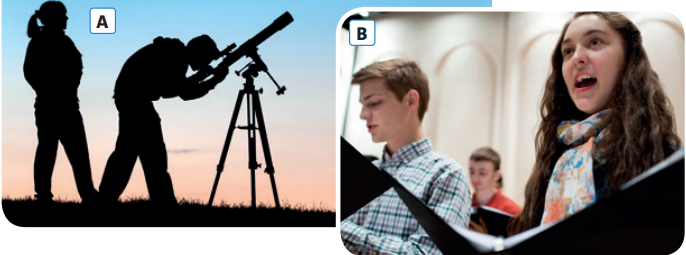
School clubs
|
art club |
astronomy club |
baking club |
|
computer club |
photography club |
film club |
|
fitness club |
school choir |
science club |
4. SPEAKING Read the Writing Strategy. In pairs, look through the blog post in exercise 2 and suggest twelve words you could delete. Then compare your ideas with another pair's.
(Đọc Chiến lược viết. Làm theo cặp, xem qua bài đăng trên blog ở bài tập 2 và gợi ý 12 từ bạn có thể xóa. Sau đó, so sánh ý tưởng của bạn với ý tưởng của cặp khác.)
|
Writing Strategy (Chiến lược viết) Where there is a word limit for the writing task, make sure you keep within it. If you went over the limit, decide which words you can delete. For example, there may be unnecessary adjectives or examples. When you have cut the words, make sure that a) the text still makes sense and b) all points in the task are still covered. (Trong trường hợp có giới hạn từ cho bài viết, hãy đảm bảo rằng bạn giữ trong giới hạn đó. Nếu bạn đã vượt quá giới hạn, hãy quyết định những từ nào bạn có thể xóa. Ví dụ, có thể có những tính từ hoặc ví dụ không cần thiết. Khi bạn đã cắt các từ, hãy đảm bảo rằng a) văn bản vẫn có nghĩa và b) tất cả các điểm trong nhiệm vụ vẫn được bao phủ.) |
2. What greenhouse gases are produced through human activities? Match column A with column B to have an answer.
(Những loại khí nhà kính được sản xuất thông qua các hoạt động của con người? Nối cột A với cột B để có câu trả lời.)
|
A. Refrigerator Aerosols (thiết bị làm lạnh) Cattle-Fertiliser (gia súc-phân bón) Oil-Coal (dầu - than) Gasoline-Agriculture (xăng dầu - nông nghiệp) |
B. CH4 N3O CO2 CFCs |
3. VOCABULARY Check the meaning of the following words or phrases. Which is not related to global warming?
(Kiểm tra nghĩa của các từ hoặc cụm từ sau. Từ nào không liên quan đến sự nóng lên toàn cầu?)
|
deforestation |
industrialisation |
climate change |
emissions |
|
habitat destruction |
animal poaching |
ice melting |
population growth |


